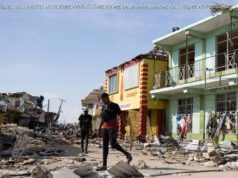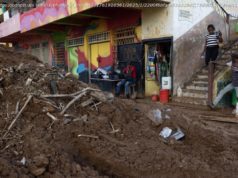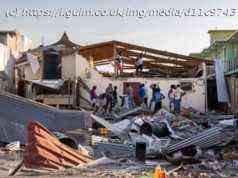Dramatic stories of heroism and failure, including the rescue of the Texas toddler Jessica McClure and the Sago mine disaster.
After two weeks of huddling in a flooded cave in northern Thailand, several of the 12 boys who were trapped with their soccer coach have been rescued in a harrowing extraction that could take days to complete.
Divers on Sunday began pulling the boys to safety through long, narrow passageways that are challenging for even the most skilled cave divers. With the world watching, the rescue team was racing against rising floodwaters in what has become one of the most engrossing rescue missions in recent years.
Here is a look at other underground rescue attempts — some successful, some not — that have transfixed people around the world.
A blast at a coal mine in northeast India triggered flooding from a nearby reservoir that killed hundreds of miners .
In response to a plea from Prime Minister Indira Gandhi, the United States, France and Switzerland rushed to deliver high-capacity pumps to drain the water, but the men were already feared dead. As one government official said at the time, it would take a miracle to save them.
Ten hours after the disaster, four bodies were removed, a grim indication of what was to come, The Associated Press reported .
There was debate about exactly how many miners were trapped. The Indian press initially said about 900 workers were in the mine, but Indian censors ordered the story suppressed, The A. P. said. A government official later told reporters that there were “heavy casualties” and that there were 250 to 300 miners trapped.
Government officials eventually conceded that the death toll could exceed 400, Reuters reported. Union members and mining experts said the number of miners trapped was most likely closer to 700.
The cause of the explosion is not known.
After being trapped for two and a half days in an abandoned water well in West Texas, an 18-month-old toddler emerged in a rescuer’s arms, caked with dirt and wrapped in bandages.
Hundreds of workers from surrounding oil fields worked to rescue the child, Jessica McClure, who fell 22 feet while playing at the home of her aunt.
“All across the world people were watching this thing in Midland, Texas, and if they didn’t get a tear in their eye, they’re not human,” James Shaw, who helped operate the drilling rig used to free Jessica, said at the time. “I know there were tears in my eye, and I’m not afraid to tell you that.”
Baby Jessica, as she came to be known, did not receive any critical injuries.
Last year, in an interview with People magazine on the 30th anniversary of her rescue, Jessica — who is now married with two children and goes by Jessica McClure Morales — said she had few visible signs of her ordeal.
“There were a few times I was picked on specifically for being ‘Baby Jessica,’” she told People. “I had a kid that called me ‘well-dweller’ for a good couple of years.”
She taught her children about the importance of kindness. “That part of my life made me the kind of mom that I am: to express to my kids that it’s not right,” she said. “My kids have good hearts.”
“They’re Alive!” one newspaper headline trumpeted. “Miner Miracle!” another said. As newspapers rushed to press after a mine explosion in Sago, W. Va., false reports abounded that 12 of the 13 miners trapped had survived the blast.
In reality, only one man was rescued alive after being confined for more than 40 hours. Twelve others died, one from the initial explosion and 11 from carbon monoxide poisoning.
It wasn’t just a few newspapers that got it wrong.
A spokesman for the Newseum, a museum about the media, told USA Today that it had examined 250 United States newspapers, and slightly more than half — including The New York Times — had published front-page stories that said the miners were alive.
Family members of the miners and a government official told reporters at the time that most of the miners had been found alive.
Bill Tucker, a member of the rescue crew, testified at a hearing that when he heard the moans of Randal McCloy Jr., the lone survivor, he turned and yelled to his fellow rescuers, “They’re alive!”
“That may have been the start of the miscommunication,” Mr. Tucker, an assistant inspector for the West Virginia Office of Miners’ Health Safety and Training, said at the hearing.
In an interview with investigators about six months after the blast, Mr. McCloy said the men had anticipated help from a machine, but that help never arrived, The A. P. reported .
“I figured they’d bring that machine down and would have found us, would have drilled the hole in the right spot and would have took us out of there,” he said, but they didn’t hear anything, adding, “We banged and banged and banged. Everyone did.”
After more than two months trapped in a mine in Chile, 33 miners escaped via a capsule painted red, white and blue, the colors of their country’s flag.
One miner, Juan Illanes, described his journey to freedom as being “like a cruise!” the BBC reported .
Claudio Yanez, the eighth miner to be rescued, applauded as he was carried away in a stretcher. His girlfriend had proposed to him in a letter sent while he was trapped.
President Sebastián Piñera had staked his presidency on rescuing the miners, who were confined in a dank space 2,000 feet below the surface.
They were trapped by a cave-in and the country’s mining minister said their chances of having survived were slim.
But Mr. Piñera felt differently. “I had a strong conviction, very deep inside of me, that they were alive, and that was a strong support for my actions,” he said later that month.
The rescue of the last of the miners brought applause and cheers in the public square of Copiapo, Chile, and their worldwide audience — watching on television, computers and cellphones — laughed and cried.






